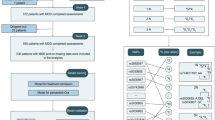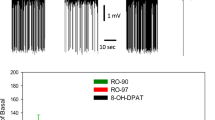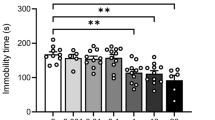Abstract
The concern that antidepressant (AD) drugs, especially selective serotonin reuptake inhibitors and paroxetine (PAR) in particular, can increase suicidality during the early treatment of juvenile patients (children and adolescents) has created a dilemma for clinicians treating depressives. Although preclinical research cannot resolve controversy in this area, our present findings may provide insight into how AD drugs might, under certain conditions, exacerbate rather than ameliorate the depressive state. Both clinical and preclinical evidences indicate that the principal noradrenergic cell group in the brain, the locus coeruleus (LC), is overactive in depressives and that, conversely, effective AD treatments decrease the activity of LC neurons. We report here that short-term (2 and 4 days) administration of PAR produces an increase in the activity of LC neurons (spontaneous firing rate and sensory-evoked responses) in young rats, contrary to the ‘therapeutic’ decrease in activity typically observed in adult rats. Blood levels of PAR were lower in young rats than in adult rats, although similar low blood levels produced by a lower dose of PAR in adult rats failed to produce an increase in LC activity. In addition, activity of young rats in the swim test was determined to assess depressive-like responses. The same dose/durations of PAR, which produced the largest increases in LC activity in young rats, produced decreases in swim-test activity, indicating that brief administration of PAR in young rats can promote, rather than reduce, the depressive state. These results offer a model that may help screen potential adjunctive treatments to avoid early adverse effects of ADs.
Similar content being viewed by others
Log in or create a free account to read this content
Gain free access to this article, as well as selected content from this journal and more on nature.com
or
References
Aston-Jones G, Bloom FE (1981). Activity of norepinephrine-containing locus coeruleus neurons in behaving rats anticipates fluctuations in the sleep-wake cycle. J Neurosci 1: 876–886.
Bailly D (2008). Benefits and risks of using antidepressants in children and adolescents. Expert Opin Drug Saf 7: 9–27.
Barbui C, Esposito E, Cipriani A (2009). Selective serotonin reuptake inhibitors and risk of suicide: a systematic review of observational studies. CMAJ 180: 291–297.
Bogetto F, Bellino S, Revello RB, Patria L (2002). Discontinuation syndrome in dysthymic patients treated with selective serotonin reuptake inhibitors: a clinical investigation. CNS Drugs 16: 273–283.
Borsody MK, Weiss JM (1996). Influence of corticotrophin-releasing hormone on electrophysiological activity of locus coeruleus neurons. Brain Res 724: 149–168.
Brent DA (2004). Treating depression in children: antidepressants and pediatric depression—the risk of doing nothing. N Engl J Med 351: 1598–1601.
Brent DA, Baugher M, Bridge J, Chen T, Chiappetta L (1999). Age- and sex-related risk factors for adolescent suicide. J Am Acad Child Adolesc Psych 38: 1497–1505.
Bridge JA, Iyengar S, Salary CB, Barbe RP, Birmaher B, Pincus HA et al (2007). Clinical response and risk for reported suicidal ideation and suicide attempts in pediatric antidepressant treatment: a meta-analysis of randomized controlled trials. JAMA 297: 1683–1696.
Cipriani A, Barbui C, Geddes JR (2005). Suicide, depression, and antidepressants. BMJ 330: 373–374.
Doggrell SA (2005). Fluoxetine—do the benefits outweigh the risks in adolescent major depression? Expert Opin Pharmacother 6: 147–150.
Ehnvall A, Sjogren M, Zachrisson CG, Agren H (2003). Lifetime burden of mood swings and activation of brain norepinephrine turnover in patients with treatment-refractory depressive illness. J Affect Disord 74: 185–189.
Fergusson D, Douucette S, Glass KC, Shapiro S, Healy D, Hebert P et al (2005). Association between suicide attempts and selective serotonin reuptake inhibitors: systematic review of randomized controlled trials. BMJ 330: 396–399.
Foote SL, Aston-Jones G, Bloom FE (1980). Impulse activity of locus coeruleus neurons in awake rats and monkeys is a function of sensory stimulation and arousal. Proc Natl Acad Sci USA 77: 3033–3037.
Gibbons RD, Hur K, Bhaumik DK, Mann JJ (2005). The relationship between antidepressant medication use and rate of suicide. Arch Gen Psychiatry 62: 165–172.
Goodman WK, Murphy TK, Storch EA (2007). Risk of adverse behavioral effects with pediatric use of antidepressants. Psychopharmacology 191: 87–96.
Graham AW, Aghajanian GK (1971). Effects of amphetamine on single-cell activity in a catecholamine nucleus, the locus coeruleus. Nature 234: 100–102.
Grant MM, Weiss JM (2001). Effects of chronic antidepressant drug administration and electroconvulsive shock on locus coeruleus electrophysiological activity. Biol Psychiatry 49: 117–129.
Hall WD, Mant A, Mitchell PB, Rendle VA, Hickie IB, McManus P (2003). Association between antidepressant prescribing and suicide in Australia, 1991–2000: trend analysis. BMJ 326: 1008.
Hammad TA, Laughren T, Racoosin J (2006). Suicidality in pediatric patients treated with antidepressant drugs. Arch Gen Psychiatry 63: 332–339.
Jick H, Kaye JA, Jick SS (2004). Antidepressants and the risk of suicidal behaviors. JAMA 292: 338–343.
Kaye CM, Haddock RE, Langley PF, Mellows G, Tasker TCG, Zussman BD et al (1989). A review of the metabolism and pharmacokinetics of paroxetine in man. Acta Psychiatr Scand 80 (Suppl 350): 60–75.
Korf J, Bunney BS, Aghajanian GK (1974). Noradrenergic neurons: morphine inhibition of spontaneous activity. Eur J Pharmacol 25: 165–169.
Laughren TP (2006). November 16, 2006 Memorandum: overview for December 13 meeting of psychopharmacology drugs advisory committee. Food and Drug Administration, Center for Drug Evaluation & Research. Available at: http://www.fda.gov/OHRMS/DOCKETS/AC/06/briefing/2006-4272b1-01-FDA.pdf. Accessed on 1 February 2007.
Lundmark J, Scheel Thomsen I, Fjord-Larsen T, Manniche PM, Mengel H, Moller-Nielsen EM et al (1989). Paroxetine: pharmacokinetic and antidepressant effect in the elderly. Acta Psychiatr Scand 80 (Suppl 350): 76–80.
Mann JJ, Emslie G, Baldessarini RJ, Beardslee W, Fawcett JA, Goodwin FK et al (2006). ACNP task force report on SSRIs and suicidal behavior in youth. Neuropsychopharmacology 31: 473–492.
McConathy J, Capello C, Jarkas N, Stowe ZN, Owens MJ (2007). Preparation of antidepressants for use in preclinical research. Internat J Neuropsychopharmacology 10: 759–763.
Mosholder AD, Willy M (2006). Suicidal adverse events in pediatric randomized, controlled clinical trials of antidepressant drugs are associated with active drug treatment: a meta-analysis. J Child Adolesc Psychopharmacol 16: 25–32.
National Strategy for Suicide Prevention. http://mentalhealth.samhsa.gov/suicideprevention/depression.asp. Accessed on December 2007.
Nestler EJ, McMahon A, Sarban EL, Tallman JF, Duman RS (1990). Chronic antidepressant administration decreases the expression of tyrosine hydroxylase in the rat locus coeruleus. Proc Natl Acad Sci USA 87: 7522–7526.
Newman TB (2004). Treating depression in children: a black-box warning for antidepressants in children? N Engl J Med 351: 1595–1598.
Oh J, Zupan B, Gross S, Toth M (2009). Paradoxical anxiogenic response of juvenile mice to fluoxetine. Neuropsychopharmacology 34: 2197–2207.
Olfson M, Marcus SC (2008). A case-control study of antidepressants and attempted suicide during early phase treatment of major depressive episodes. J Clin Psychiatry 69: 425–432.
Olfson M, Marcus SC, Shaffer D (2006). Antidepressant drug therapy and suicide in severely depressed children and adults. A case-control study. Arch Gen Psychiatry 63: 865–872.
Olfson M, Shaffer D, Marcus SC, Greenberg T (2003). Relationship between antidepressant medication treatment and suicide in adolescents. Arch Gen Psychiatry 60: 978–982.
Ordway GA, Smith KS, Haycock JW (1994). Elevated tyrosine hydroxylase in the locus coeruleus of suicide victims. J Neurochem 62: 680–685.
Pfeffer CR, Klerman GL, Hurt SW, Lesser M, Peskin JR, Siefker CA (1991). Suicidal children grow up: demographic and clinical risk factors for adolescent suicide attempts. J Am Acad Child Adolesc Psych 30: 609–616.
Preskorn SH (1997). Clinically relevant pharmacology of selective serotonin reuptake inhibitors. An overview with emphasis on pharmacokinetics and effects on oxidative drug metabolism. Clin Pharmacokinetics 32 (Suppl 1): 1–21.
Richmond TK, Rosen DS (2005). The treatment of adolescent depression in the era of the black box warning. Curr Opin Pediatr 17: 466–472.
Ritchie JC, Glover B, Ramsey C, Scott-Harrell, P (2009). A routine UPLC-ms/ms assay for the newer antidepressants. Ther Drug Monit 31: 646.
Ryan ND (2005). Treatment of depression in children and adolescents. Lancet 366: 933–940.
Scahill L, Hamrin V, Pachler ME (2005). The use of selective serotonin reuptake inhibitors in children and adolescents with major depression. J Child Adolesc Psychiatr Nurs 18: 86–89.
Shaffer D, Gould MS, Fisher P, Trautman P, Moreau D, Kleinman M et al (1996). Psychiatric diagnosis in child and adolescent suicide. Arch Gen Psychiatry 53: 339–348.
Simson PE, Weiss JM (1987). Alpha-2 receptor blockade increases responsiveness of locus coeruleus neurons to excitatory stimulation. J Neurosci 7: 1732–1740.
Simson PE, Weiss JM (1988). Altered activity of the locus coeruleus in an animal model of depression. Neuropsychopharmacology 1: 287–295.
Simson PE, Weiss JM, Hoffman LJ, Ambrose MJ (1986). Reversal of behavioral depression by infusion of an alpha-2 adrenergic agonist into the locus coeruleus. Neuropharmacology 25: 385–389.
Stephens MA (2008). The black hole of the black box for antidepressants. Clinical Compass 3: 1–2.
Taravosh-Lahn K, Bastida C, Delville Y (2006). Differential responsiveness to fluoxetine during puberty. Behav Neuroscience 120: 1084–1092.
Tiihonen J, Lonnqvist J, Wahlbeck K, Klaukka T, Tanskanen A, Haukka J (2006). Antidepressants and the risk of suicide, attempted suicide, and overall mortality in a nationwide cohort. Arch Gen Psychiatry 63: 1358–1367.
Vitiello B, Swedo S (2004). Antidepressant medications in children. N Engl J Med 350: 1489–1491.
Weiss JJ, Gorman JM (2005). Antidepressant adherence and suicide risk in depressed youth. Am J Psychiatry 162: 1756–1757.
Weiss JM, Bonsall RW, Demetrikpoulos MK, Emery MS, West CHK (1998). Galanin: a significant role in depression? In: Hokfelt T, Bartfai T, Crawley J (eds). Galanin: Basic Research Discoveries and Therapeutic Implications. The New York Academy of Sciences: New York pp 364–382.
Weiss JM, Boss-Williams KA, Moore JP, Demetrikopoulos MK, Ritchie JC, West CHK (2005). Testing the hypothesis that locus coeruleus hyperactivity produces depression-related changes via galanin. Neuropeptides 39: 281–287.
Weiss JM, Demetrikopoulos MK, West CHK, Bonsall RW (1996). An hypothesis linking noradrenergic and dopaminergic systems in depression. Depression 3: 225–245.
West CHK, Ritchie JC, Boss-Williams KA, Weiss JM (2009). Antidepressant drugs with differing pharmacological actions decrease activity of locus coeruleus neurons. Internat J Neuropsychopharmacology 12: 627–641.
West CHK, Weiss JM (1998). Effects of antidepressant drugs on rats bred for low activity in the swim test. Pharmacol Biochem Behav 61: 67–79.
Whittington CJ, Kendall T, Fonagy P, Cottrell D, Cotgrove A, Boddington E (2004). Selective serotonin reuptake inhibitors in childhood depression: systematic review of published versus unpublished data. Lancet 363: 1341–1345.
Wohlfarth TD, van Zwieten BJ, Lekkerkerker LJ, Gispen-de Wied CC, Ruis JR, Elferink AJ et al (2006). Antidepressants use in children and adolescents and the risk of suicide. Eur Neuropsychopharmacol 16: 79–83.
Wong M-L, Kling MA, Munson PJ, Listwak S, Licinio J, Prolo P et al (2000). Pronounced and sustained central hypernoradrenergic function in major depression with melancholic features: relation to hypercortisolism and corticotrophin releasing hormone. Proc Natl Acad Sci 97: 325–330.
Yerevanian BI, Koek RJ, Feusner JD, Hwang S, Mintz J (2004). Antidepressants and suicidal behavior in unipolar depression. Acta Psychiatr Scand 110: 452–458.
Zhu M-Y, Klimek V, Dilley G, Haycock J, Stockmeier C, Overholser J et al (1999). Elevated levels of tyrosine hydroxylase in the locus coeruleus in major depression. Biol Psychiatry 46: 1275–1286.
Acknowledgements
We thank Dr Michael Owens of Emory University for his help in preparing the paroxetine used in this study. This research was supported by the Public Health Services Grant MH079794.
Author information
Authors and Affiliations
Corresponding author
Ethics declarations
Competing interests
The authors declare no conflict of interest.
Rights and permissions
About this article
Cite this article
West, C., Ritchie, J. & Weiss, J. Paroxetine-Induced Increase in Activity of Locus Coeruleus Neurons in Adolescent Rats: Implication of a Countertherapeutic Effect of an Antidepressant. Neuropsychopharmacol 35, 1653–1663 (2010). https://doi.org/10.1038/npp.2010.34
Received:
Revised:
Accepted:
Published:
Issue date:
DOI: https://doi.org/10.1038/npp.2010.34
Keywords
This article is cited by
-
Central nervous system effects of prenatal selective serotonin reuptake inhibitors: sensing the signal through the noise
Psychopharmacology (2013)
-
Addendum: Paroxetine-Induced Increase in Activity of Locus Coeruleus Neurons in Adolescent Rats: Implication of a Countertherapeutic Effect of an Antidepressant
Neuropsychopharmacology (2010)



